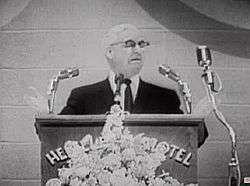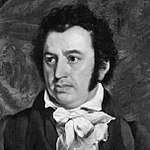George S. Benson
George Stuart Benson (September 26, 1898—December 15, 1991)[1] was an American missionary, college administrator, and conservative political activist. After fleeing communist uprisings in China as a missionary, Benson became an anticommunist and conservative activist, taking stances against the New Deal, and later, racial integration. Benson served for many years as the president of Harding College, and oversaw a large propaganda network through his National Education Program, which sponsored short cartoons, "Freedom Forums" (gatherings of business people to promote the American way), and lecture tours for Benson.
George Stuart Benson | |
|---|---|
 Benson as he appeared in the Harding-produced The War We Are In, Part 2 anticommunist film, 1962. | |
| Born | September 26, 1898 |
| Died | December 15, 1991 (aged 93) |
| Resting place | Oak Grove Cemetery, Searcy, Arkansas |
| Nationality | American |
| Alma mater | Harding College |
| Occupation | Missionary College administrator Conservative political activist |
| Spouse(s) | Sally Ellis Hockaday, Marguerite O’Banion |
| Children | Two daughters |
Career
George S. Benson started his career of religious and political education as a missionary to what is now Guangzhou, China, for eleven years, 1925-1936. He left China in 1936, at the invitation of J.N. Armstrong, to become president of Harding College.[2] Early in his career as president of Harding College, he established on campus the National Education Program (NEP) which became a bastion of radical right-wing political activism.[3] He worked closely with Harding professor James D. Bales. Conducting a broad range of activities, including a film series, and both a nationally syndicated newspaper column and radio show by Benson, its activities reached many millions of Americans. As a result of these activities, Harding and the NEP were widely known for an association with patriotism and free-enterprise information in America. This represented a dramatic turn from the anti-political and pacifist values of founding influences James A. Harding and David Lipscomb. Naturally, this nationalism resonated both with its proponents and its opponents. "Benson initially resisted overtures by students and faculty to begin the process of desegregating Harding, but in the fall of 1963 he announced that the school would be admitting its first black students."[4] About this time, Harding College also received its first substantial national opposition and criticism in the news media, much of it in association with criticism of the movement supporting the Barry Goldwater campaign.
Benson influenced nationalist agendas at other Church of Christ-related institutions also. The American Studies Institute at Abilene Christian College and the American Citizenship Center at Oklahoma Christian University were among the programs initially modeled on his work at Harding with the NEP. Following his resignation from the presidency of Harding in 1965, he continued to assist in the development of several other Church of Christ-related institutions, including Oklahoma Christian University, Lubbock Christian College, Alabama Christian College (Now Faulkner University), and George Pepperdine College. Benson also exerted a significant influence on the political culture of Churches of Christ. While some Churches of Christ saw this as a favorable development, others saw it as an abandonment of early values, and this conservative and nationalistic emphasis received substantial criticism beginning in the mid-60s.
Benson believed that black people were "Under the curse of Ham", a reference to one of Noah's son in the book of Genesis that was often used as a biblical justification of segregation and inferiority of black people,[5] and therefore strongly resisted integration at Harding, and in the public schools. "The Little Rock Nine," he said, "left a far better building and their own teachers to go to Central". When students and faculty disagreed, he had them removed from Harding.[6] In 1957, student body president Bill Floyd circulated a "statement of attitude" that affirmed that the signers were ready to accept black students. Before this had circulated, Benson announced in the required daily chapel that students should not sign it, yet over 85 percent of the student body and almost one hundred faculty and staff signed this document and forwarded it to the trustees. Benson dismissed the statement as "an inaccurate expression of student feeling."[5] The following day students posted an ironic "whites only" sign in the lily pool, a decorative pond that serves as the central gathering place on the Searcy campus.[5] Benson enlisted professor James D. Bales to quiet students concerns. Bales expounded that segregation should be viewed as a local custom and a tradition that should be respected. He stated his belief that no matter what their station in life, God accepted all people. However, in the New Testament, the church did not dismantle social hierarchies, and that acts that were offensive to some church members (as in the eating of meat sacrificed to idols) were avoided so as not to offend them. Bales said that desegregation should be viewed the same way.[5]
Benson continued to resist integration until the Civil Rights Act forced him to acquiesce or lose federal funding.[7] He maintained that racial segregation was the natural order of divine creation. Benson warned that integration would lead to increases in crime and venereal disease, and that mixed marriages would lead to broken homes and an increase in crime.[7][8] In a 1966 sermon he maintained that "Before God, all men are equal, but in like manner there is no reason to think the Lord wants a mixing of the races and the creating of just one mongrel race."[6][5] Buildings are named in his honor at Harding University, Freed Hardeman University, Faulkner University, and Oklahoma Christian University. Ironically, the Benson Administration building at Oklahoma Christian was the site of a student-led civil rights event in 1969 which ultimately led to 18 students being arrested and expelled.[9] The George Benson Christian College [10] is located in Zambia, Africa on the Namwianga Mission site.
Honors
Benson was a recipient of the Tax Foundation's Distinguished Service Award in 1941.[11] Dr. Benson was inducted into the Oklahoma Hall of Fame in 1972[12] and to the Oklahoma State University Hall of Fame in 1976.[13]
External links
- Oklahoma Christian University History Through The Ages - George Benson
- The War We Are In, Part 2 - Televised speech by Dr. Benson
- Knox College Honorary Doctorate Recipients
- Burial site
- Encyclopedia of Arkansas History and Culture Encyclopedia of Arkansas
Bibliography
Missionary Experiences. Edmond, OK. 1987.
Hicks, L. Edward (1994). Sometimes in the Wrong But Never in Doubt: George Benson and the Education of the New Religious Right. Knoxville. ISBN 0-87049-865-7.
Stevens, John C. (1991). Before Any Were Willing: The Story of George S. Benson. Searcy, AR.
Donald P. Garner (1963), George S. Benson: Conservative, Anti-Communist, Pro-American Speaker, Ph.D dissertation, Wayne State Univ.
Altman, Ted (1970), The Contributions of George S. Benson to Christian Education, Ed.D dissertation, North Texas University
Notes
- Haynie, Paul (2017). "George Stuart Benson". Encyclopedia of Arkansas History and Culture. Retrieved 2019-10-09.
- Benson, George S. (1987). Missionary Experiences. Delight, AR: Gospel Light Publishing Company. pp. 103–104.
- Maxwell, Robbie (2019). "'A Shooting Star of Conservatism': George S. Benson, the National Education Program and the 'Radical Right'". Journal of American Studies. 55: 372–373.
- "Encyclopedia of Arkansas". Encyclopedia of Arkansas.
- Key, Barclay. Race and Restoration: churches of Christ and the African American Freedom Struggle. p. 85.
- Myers, Robert (January 1, 1966). Voices of Concern; Critical Studies in Church of Christism. Mission Messenger.
- Brown, Michael D (6 June 2012). "Despite school sentiment, Harding's leader said no to integration". Arkansas Times. Retrieved 29 December 2018.
- Dailey, Zach (September 12, 2016). "A Year Of Amazing Grace Will Harding look back or forge a new path forward?". Retrieved 2 October 2019.
In the talk, Benson defended segregation, claiming that equal educational opportunities were available without the need for integration, that integration was an evil that would "increase destruction to properties, increase gonorrhea and syphilis, and increase pregnancies." He opined that mixed marriages would lead to broken homes and increased crime, ending his remarks with "the blackbirds and bluebirds, the blue jays and mockingbirds, they don't mix and mingle together, young people!"
- Tryggestad, Erik (March 29, 2019). "After 50 years, an apology". Retrieved 5 June 2020.
- "Archived copy". Archived from the original on 2008-07-04. Retrieved 2008-09-28.CS1 maint: archived copy as title (link)
- "Archived copy". Archived from the original on 2008-10-27. Retrieved 2008-09-28.CS1 maint: archived copy as title (link)
- "Login/Logout". securelb.imodules.com.
